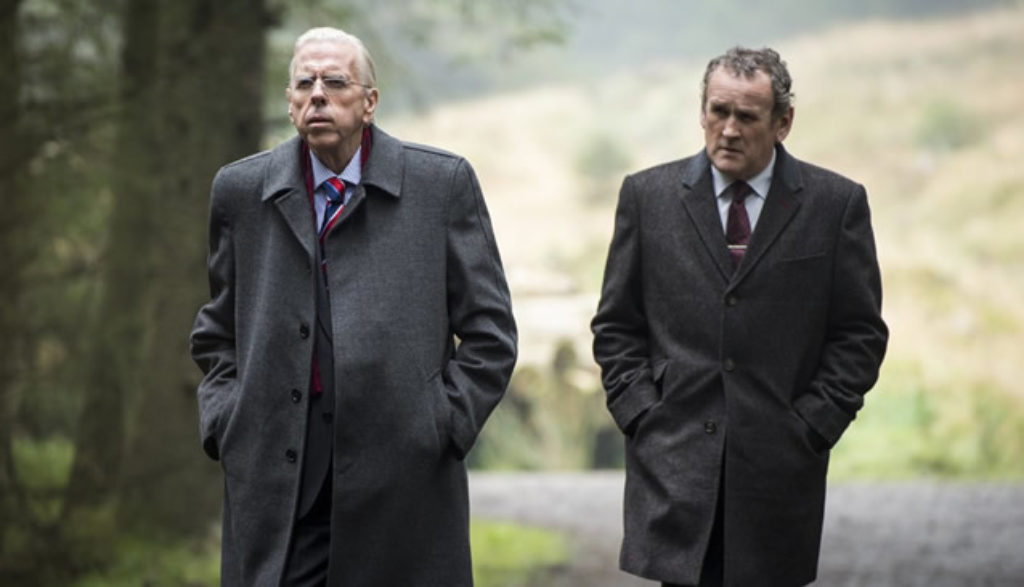
For 40 years, Northern Ireland was plagued by a bloody conflict that resulted in thousands of deaths. At its heart lay two mutually exclusive visions of national identity: the Protestant majority who were staunchly loyal to the United Kingdom, and the embattled Catholic minority who favored Irish unification.
Then in 2006, the leading players—Unionist Rev. Ian Paisley and Irish Republican Martin McGuiness—met to see if some kind of compromise, some sort of lasting peace might be hammered out.
But after years and years of armed conflicts, murderous terror, funerals, heated rhetoric and firebrand speeches, how could there ever be common ground? How could bitter anger give way to agreement, hatred to a handshake?
It seemed impossible. But somehow it happened.
The Journey dramatically imagines how that tugging, pulling and transforming reconciliation process might have taken place.
The path forward is, without a doubt, a difficult one in this story. But as Paisley and McGuiness are prompted to hesitantly talk—through the under-the-table machinations of their support staffs—they realize that “winning” their ongoing war is a futile pursuit. They also begin to admit that the conflict has taken a devastating toll.
McGuiness recounts the day when he saw a certain horror in his young daughter’s eyes and realized that his side’s “freedom fighting” actions weren’t as upright and defensible as he had always believed. In a way, Paisley agrees. “Some have said that the past is a foreign country—they do things differently there. Maybe we need to do things different,” he opines. Ultimately the men forge an agreement and a tenuous-but-mutual respect. And the film tells us that in later years that uneasy beginning became a strong bond.
Rev. Paisley is man of pious faith (though he sometimes displays it in sanctimonious ways). He prays openly to Jesus a couple of times. He preaches a mini-sermon of sorts (about Jesus and the money changers) to a service station attendant. Paisley also earnestly rebukes McGuiness for taking the Lord’s name in vain and wonders if the man is trying to tempt him as Satan did Jesus.
Later, Paisley softens his tone and wonders if God might have brought him together with McGuiness for an important moment in time. McGuiness believes that might be true. He even compares the two men’s peace efforts—which are largely opposed by many of each side’s respective constituents—to a sort of martyrdom.
Meanwhile, referencing The Exorcist …
… McGuiness jokingly begins to quote a line from the film, “Your mother sucks …” but leaves that crude dialogue unfinished.
At different times, we see still photos of IRA terrorist attacks that include explosions, fires and bloodied people. Paisley and McGuiness talk about going to funerals for people who have died on both sides of the conflict. They also get pretty heated about innocents who were killed.
McGuiness describes how the U.S. 9/11 attacks influenced the terrorism conversation in Ireland. “For terror to be effective now, it has to be massive,” he states with a weary headshake. McGuiness also declares that the IRA never attempted to harm Paisley, even though the reverend still believes that the group had made attempts on his life. McGuiness counters that no such attempts were made, in part because Paisley’s fiery rhetoric against Catholics actually served their cause: “You have done more damage to your own lot then the IRA could have done with a thousand bombs.”
One f-word and two misuses of Jesus’ name join a handful of uses of “h—” and “d–n,” as well as exclamations of the English crudity “bloody.”
We see an empty bottle of alcohol in a decrepit church. Paisley takes a prescription drug after collapsing with a physical malady.
McGuiness jokes about Paisley’s 50-year marriage: “You’d get less time for murder,” he says with a smirk.
Feeling more like a stage play than a movie, The Journey focuses on the imagined interactions between two key players in Northern Ireland’s desperately needed peace process. And though this dramatic device can feel a bit small and slow for a big screen presentation, the film nevertheless provides an insightful window into this decades-long struggle.
Actors Timothy Spall and Colm Meany both portray their roles powerfully. Their verbal sparring and give-and-take maneuverings make for a compelling performance.
That said, this engaging historical drama isn’t one every family will want to rush out and see. The quiet pace won’t sit well with the fidget-spinning, superhero-loving younger set. And the film’s occasional harsh profanities likely won’t sit well with parents of younger viewers, either.
But for fans of historical drama who want to be educated while being entertained, The Journey offers fodder for some serious pie-and-coffee discussion after the credits roll.


After spending more than two decades touring, directing, writing and producing for Christian theater and radio (most recently for Adventures in Odyssey, which he still contributes to), Bob joined the Plugged In staff to help us focus more heavily on video games. He is also one of our primary movie reviewers.